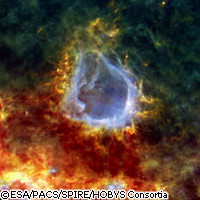A star is born - and caught on film!
Striking new images taken from Herschel (the European Space Agency's (ESA's) infrared space telescope) reveal stars in various stages of formation. Researchers predict that in the next 100,000 years or so, one embryonic star in particular will be among the biggest in our galaxy. The telescope's images suggest that this baby star, nestled on the star-forming cloud RCW 120, is already 10 times the mass of the Sun. When a star forms, surrounding dust and gas begin to heat up and emit light at far-infrared wavelengths. These wavelengths are almost always blocked by the Earth's atmosphere, making observations of star birth possible only from space. Herschel was launched into space, together with the ESA's Planck spacecraft, on 14 May 2009. To date, it is the largest astronomical telescope ever to have been dispatched (its main mirror is four times larger than any previous infrared space telescope). Its first set of results provides information on star-forming regions in our own galaxy and beyond, such as star-forming clouds scattered across the Milky Way and images of thousands of galaxies manically producing stars. These discoveries have already begun to challenge current theories and inspire new avenues of research. As for the big baby star on cloud RCW 120, Dr Annie Zavagno from Laboratoire d'Astrophysique de Marseille in France said that this star, rather remarkably, still has some growing to do. 'According to our current understanding, you should not be able to form stars larger than eight solar masses,' explained Dr Zavagno. The reason for this theory is that the intense light emitted by a large star destroys its birth cloud before it can accumulate any more mass. Nevertheless, these 'impossible' stars do form, with some containing up to 150 solar masses. With the data generated by Herschel, researchers now have the chance to study one of these big stars in its infancy. 'Before Herschel, it was not clear how the material in the Milky Way came together in high enough densities and at sufficiently low temperatures to form stars,' added Dr Sergio Molinari from Italy's Istituto di Fisica dello Spazio Interplanetario, Roma. An image from the telescope now reveals that stellar embryos first appear inside filaments of glowing dust and gas that form chains of star nurseries tens of light-years long. These chains then cover the galaxy with newborn stars. Beyond just stars themselves, Herschel has also made the first discovery in space of a new, electrically charged 'phase' of water: ultraviolet light in the clouds surrounding young stars pumps through the gas, and can knock an electron out of the water molecule. Dr Arnold Benz of Eidgenössische Technische Hochschule (ETH) Zürich in Switzerland said that this discovery of ionised water vapour came as a complete surprise. 'It tells us that there are violent processes taking place during the early birth stages, which lead to widespread energetic radiation throughout the cloud.' All of these results indicate a lot more insight into star-forming regions is possible through Herschel. 'These are still early days for Herschel and this is just the beginning of all the science that we will get from this mission in the years to come,' concluded Herschel Project Scientist Dr Göran Pilbratt.
Countries
Switzerland, France, Italy



